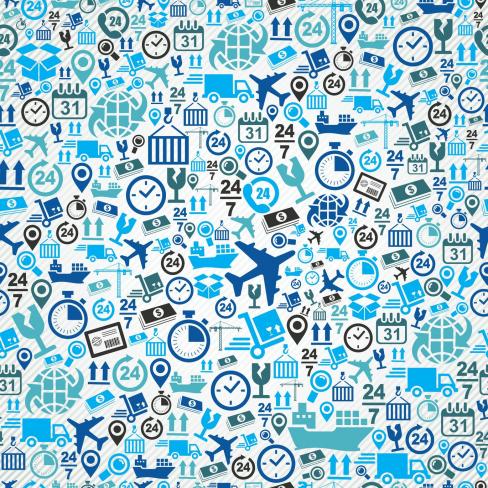
SMU’s Green Transformation Lab celebrates its third year of innovation.

Image Credit: Cienpies Design
By Laura Petersen
SMU Office of Research – The global logistics company DHL and Singapore Management University (SMU) are celebrating three years of collaboration in improving the efficiency and sustainability of shipping goods in Asia Pacific.
From televisions to t-shirts, paperclips to cars — goods travel vast distances from manufacturing plants to their final consumers. A significant contribution to a product’s environmental footprint comes from its transport.
To accelerate the evolution of sustainable logistics, DHL and SMU formed the Green Transformation Lab (GTL) in 2013. Tapping on DHL’s standing as the world’s leading logistics company to present real-world business scenarios and challenges, SMU’s faculty and students come together to work with DHL in developing new ideas and innovative solutions.
“The lab’s vision is to be the catalyst for change,” said Assistant Professor Tan Kar Way, the academic director of GTL. “We aim to create solutions for organisations and supply chains that lead to large-scale adoption so they become greener, more resource-efficient and sustainable.”
GTL’s performance in the past three years has exceeded expectations.
“We frequently are surprised by the unconventional approaches that students and the faculty choose, as well as how these approaches produce unexpected solutions to the problems,” said Stephan Schablinski, Director of Sustainable Supply Chain Solutions at DHL.
For example, GTL developed an application that optimises the choice of ocean container sizes and provides consolidation options at key ports. Many ocean shipping containers have unutilised space in them, presenting a significant opportunity to reduce carbon emissions and costs. Many manufacturers ship directly from their factories to the consumer markets without much consolidation planning. The application helps manufacturers analyse options for picking the most appropriate shipping container size, and thereafter consolidate the freight at key ports first, before forwarding the items to their destinations.
Using real data from a manufacturing company, SMU students determined that selecting optimal shipping container sizes can result in a 13.1 percent decrease in carbon emissions, and consolidating goods from multiple manufacturing plants at a port can further reduce carbon emissions by 12 percent for this company.
To help companies better understand the impact of different shipping options on carbon emissions, GTL, together with SMU students, revamped the Carbon Dashboard application to make it more visual and user-friendly. An IT application that estimates carbon emissions for shipping routes and modes, Carbon Dashboard 2.0 allows companies to explore different shipping routes and the corresponding carbon footprint, so that companies can consider the greener routes in the future. The application was fully commercialised in 2014 and is now used by DHL’s clients regularly.
“This tool enables DHL customers to really see where emissions along the supply chain are highest and try different ‘what if’ scenarios to see how they can reduce emissions and save money,” Schablinski said.
Another useful application to come out of GTL is the Online Energy Certificate, a web-based platform that DHL customers can use to measure energy efficiencies of warehouses. Developed by a group of undergraduates, the tool allows users to compare their facilities with an idealistic warehouse that adopts the best practices, to see how their warehouses can be modified to become more energy efficient. To further improve the benchmark methodology, a master’s student took the lead on developing an algorithm that enables fair benchmarking for energy consumption based on data from a large number of warehouses.
To date, more than 150 undergraduate and master’s students have worked with GTL as part of their coursework, and many have enjoyed the real-world experience presented to them.
“Students learn that the logistics and supply chain industry is actually more exciting than they initially thought, and this is an area where innovation in IT and data analytics can make a big difference,” Schablinski said. “We hope that GTL will continue to make our industry more attractive for young talent.”
The students have also helped raise awareness amongst local firms on the need for more sustainable packaging and shipping practices, and that environmentally friendly choices do not have to cost more.
“The best part of the GTL is how closely students have been able to work with local industry,” said Dr. Aparna Mukherjee Rajesh, Group Lead of Management Programmes at the SMU Lee Kong Chian School of Business. “Their research can be directly applied to real situations. I believe other departments can follow GTL’s model in making an impact in the industry.”
Apart from working with students, GTL also partners with the industry and government agencies. Environmental sustainability at ports has been receiving attention from port operators and regulators, and with the growing interest to move towards a clean and green port for Singapore, GTL worked with the Maritime Port Authority of Singapore (MPA) to develop a sustainability framework for port terminals. The framework, which covers transparency measurements, best practices, technologies and policies that allow business units in terminal operators to be accountable for their energy consumption, will help gear Singapore’s maritime operations towards sustainable green growth.
In addition, GTL conducted an analytics study for a large IT manufacturing company to locate the most suitable site for its production plants. Through considering factors such as the inbound and outbound flow of raw materials and finished goods, the study provided the company with an economical strategy in the forward planning of its operations.
As more companies reach out to GTL for collaboration on sustainability projects, Dr. Mukherjee Rajesh is thrilled, as the companies can bring in more real-life business challenges for SMU faculty and students to work on.
DHL originally seeded the lab with $2 million for an initial duration of 2 years. In 2015, DHL extended its commitment for another two years until mid-2017. Four DHL full time employees share office space with students and faculty, providing industry with insight and guidance. The tangible products produced by GTL contributed to DHL’s win of the Best Practice Leadership in Energy Management prize at the 2015 Sustainable Business Awards (SBA) Singapore, for the second year in a row.
“What makes the lab different is the unconventional mix of academic standards and commercial pragmatism, which brings completely new approaches to light,” Schablinski said.
Going forward, GTL will focus on developing the circular economy — where items once considered waste at the end of their life cycle are recycled, reused or refurbished.
To spark new ideas on circular economy practices amongst industry, GTL co-hosted a symposium on the circular economy, shared value and urban mobility. About 100 industry professionals, academics and researchers gathered to discuss how to move people and goods around cities more efficiently, as well as how to make mega cities more sustainable.
One key project that GTL has embarked on for this endeavor is the Circular Economy Tyre Study, which researches on how to reuse tires instead of piling them up in landfills. Another project, Wheels4Food, aims to help the distribution of excess food to reduce food waste. This project is a partnership with Food from the Heart, a non-profit food bank in Singapore.
“With a greater strain on resources, it is imperative to move away from the model of ‘take, make, dispose,’” said Professor Tan. “Logistics is one of the key catalysts and defining components for value creation towards new business models that incorporate circular practices.”
The lab also wants to help companies create business value by addressing social problems that intersect with their operations, something called “Shared Value.” Dr. Mukherjee Rajesh noted that often companies are viewed negatively as earning profits at the expense of the greater good.
“What if the public could see businesses doing good for their communities and simultaneously creating economic benefits for themselves? What if corporate mindsets could be changed to view environmental and social problems not as constraints, but as business opportunities?” she said. “Shared Value can help achieve the paradigm shift”.
See More News
Want to see more of SMU Research?
Sign up for Research@SMU e-newslettter to know more about our research and research-related events!
If you would like to remove yourself from all our mailing list, please visit https://eservices.smu.edu.sg/internet/DNC/Default.aspx
